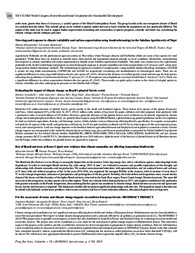Dry of Brazil nut trees at Resex Cajari: new evidence that climate anomalies are affecting Amazonian biodiversity.
Dry of Brazil nut trees at Resex Cajari: new evidence that climate anomalies are affecting Amazonian biodiversity.
Author(s): GUEDES, M. C.
Summary: The Brazil nut (Bertholletia excelsa Bonp.) is among the largest trees in the Amazon. It has big canopy area, and is a deciduous species, indicating high water dependence. In order to investigate Brazil nut trees dry, after strong ?2015 el nino?, we evaluated occurrence and possible explanations of this drought, and relationships with climatic anomalies and nut production. We conduct semi-structured interviews with agroextractivists, and we analyzed leaves and soil near at 15 trees, with and without symptoms of dry. In the years 2015/2016, was registered the strongest El Niño in the Amazon, with an increase of more than 2 °C in the average temperature, reduction of precipitation and prolongation of the dry period. Probably, the water deficit and temperature stress caused the dry (burn) of the leaves and thin branches of the higher Brazil nut trees, observed in the Santa Rosa region, Resex Cajari-Amapá, Eastern Amazonia. The same did not occur in the young trees, in other species and in other regions. There was a drastic fall in fruit production in 2017, and negative correlation of the production with positive anomalies in the Pacific temperature, demonstrating that this species has sensitivity to climate change. Brazil nut trees can recover and sprout new leaves, but the next harvest is it impaired. The nutritional variables did not present significant relationships with trees dry. The hypothesis raised is that this may be related with hydraulic conductance problems, when occurs cavitation and loss of water molecules adhesion, after physiological stress in large trees.
Publication year: 2019
Types of publication: Abstract in annals or event proceedings
Unit: Embrapa Amapá
Keywords: Castanha
Observation
Some of Embrapa's publications are published as ePub files. To read them, use or download one of the following free software options to your computer or mobile device. Android: Google Play Books; IOS: iBooks; Windows and Linux: Calibre.
Access other publications
Access the Agricultural Research Database (BDPA) to consult Embrapa's full library collection and records.
Visit Embrapa Bookstore to purchase books and other publications sold by Embrapa.

